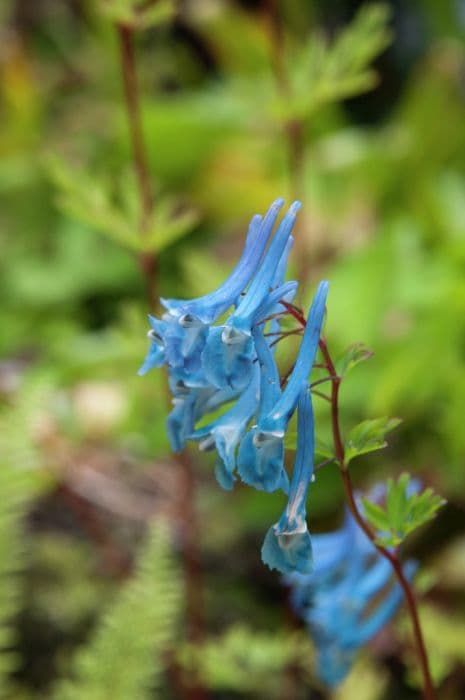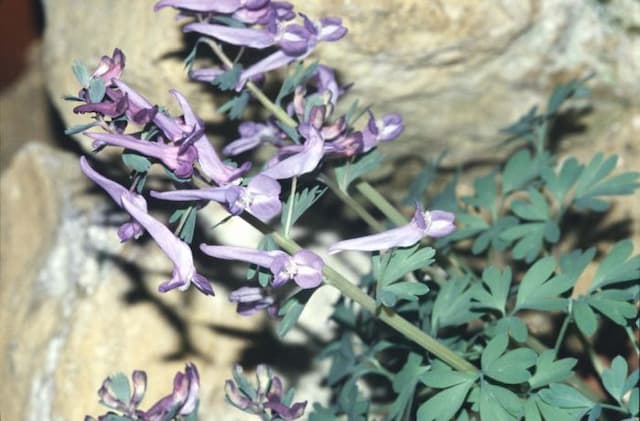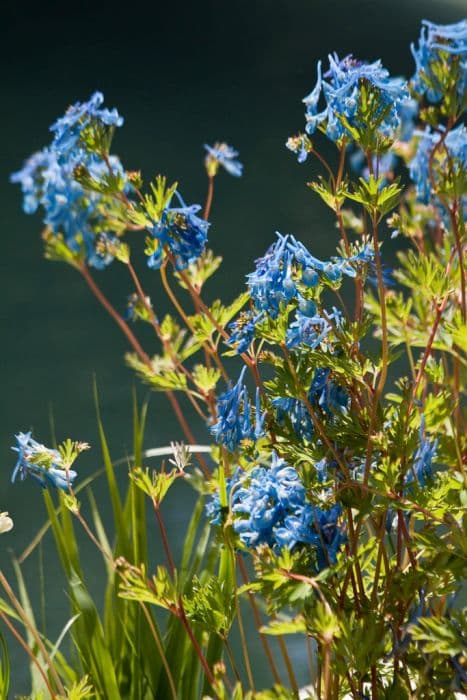Himalayan blue poppy 'Slieve Donard Meconopsis (Infertile Blue Group) 'Slieve Donard'

ABOUT
'Slieve Donard' is a short-lived perennial about 1m tall, forming an upright rosette of oval leaves covered with white hairs. In summer, erect, leafy stems bear a cluster of pure sky blue poppies 10-16cm across with contrasting yellow stamens. The seed capsules, covered in bristly hairs, are decorative but contain no viable seed
About this plant
 Names
NamesSynonyms
Slieve Donard Himalayan Poppy, Slieve Donard Blue Poppy, Slieve Donard Meconopsis.
Common names
Meconopsis (Infertile Blue Group) 'Slieve Donard'
 Characteristics
CharacteristicsLife cycle
Perennials
Foliage type
Deciduous
Color of leaves
Green
Flower color
Blue
Height
2-3 feet (60-90 cm)
Spread
1-2 feet (30-60 cm)
Plant type
Herb
Hardiness zones
5
Native area
Himalayas
Benefits
 General Benefits
General Benefits- Aesthetic appeal: The Meconopsis 'Slieve Donard' offers striking blue flowers that can enhance the beauty of any garden.
- Wildlife attraction: Its blossoms can attract pollinators such as bees and butterflies, supporting local ecosystems.
- Cool color palette: The cool blue hues can provide a calming effect in garden settings and are particularly effective in creating color contrasts with warmer-toned plants.
- Rare coloration: True blue flowers are rare in the plant kingdom, making it a unique addition to collections and displays.
- Shade gardening: This plant is well-suited for shaded areas, expanding the range of gardening possibilities in landscapes with limited sunlight.
 Medical Properties
Medical PropertiesThis plant is not used for medical purposes.
 Air-purifying Qualities
Air-purifying QualitiesThis plant is not specifically known for air purifying qualities.
 Other Uses
Other Uses- Photography Prop: The striking blue flowers of the Himalayan blue poppy can provide a stunning backdrop or focal point for garden and nature photographers.
- Fabric Dye: The petals have the potential to be used in making natural dyes for fabrics, though this practice isn't commonly reported.
- Artistic Inspiration: Artists may use the vibrant blue of the blooms as an inspiration for paintings, drawings, and other artistic creations.
- Education: Botanic gardens and educational institutions might use the Himalayan blue poppy as an example when teaching about alpine flora and specific care requirements of such plants.
- Green Gift: As a potted plant, it can serve as an eco-friendly gift choice for gardeners and flower enthusiasts who appreciate unique botanical specimens.
- Ecosystem Enrichment: In suitable habitats, the Himalayan blue poppy can add biodiversity and support the local ecosystem by providing nectar for pollinators.
- Culinary Decoration: The non-toxic flowers can be used as decorative elements on plates and cakes, but they are not commonly consumed.
- Theme Gardens: Himalayan blue poppies can be included in thematic gardens, such as blue-flower gardens or mountain-inspired landscapes.
- Collector's Item: Due to its rarity and unique beauty, the plant can be a collector's item for horticulturists and plant enthusiasts who specialize in rare alpine species.
- Winter Interest: In temperate climates, the dried seed heads of the Himalayan blue poppy can add texture and interest to an otherwise barren winter garden.
Interesting Facts
 Feng Shui
Feng ShuiThe Himalayan blue poppy is not used in Feng Shui practice.
 Zodiac Sign Compitability
Zodiac Sign CompitabilityThe Himalayan blue poppy is not used in astrology practice.
 Plant Symbolism
Plant Symbolism- Rarity: The Himalayan Blue Poppy (Meconopsis) is a rare and elusive flower, symbolizing the pursuit of the extraordinary and the value of rarity in our lives.
- Peace: Its tranquil blue hue is often associated with peace and serenity, representing a calm presence in one's life.
- Dreams: The captivating appearance of the Himalayan Blue Poppy may represent dreaming and striving towards one's goals, as it appears almost dream-like itself.
- Beauty: With its stunning blue petals, the plant is also a symbol of beauty, reminding us to appreciate the aesthetic pleasures in the world.
 Water
WaterThe Blue Poppy, including cultivars like 'Slieve Donard', needs to be kept consistently moist without being waterlogged. Water the plants deeply so that the water reaches the root zone, usually about 1 to 2 gallons per week, depending on the weather conditions and soil drainage. During hot spells or dry periods, it may be necessary to water more frequently, ensuring that the soil doesn't dry out completely. Conversely, in cooler or rainy periods, reduce the watering accordingly, but never let the soil become completely dry. Overhead watering should be avoided to prevent leaf and flower diseases.
 Light
LightThe Blue Poppy prefers a sheltered position with dappled sunlight or partial shade, especially in areas with hot summers. The ideal spot for this plant would protect it from the harsh afternoon sun while providing enough morning light or light filtered through canopy leaves. Direct sunlight can scorch the delicate leaves and petals, especially in warmer climates.
 Temperature
TemperatureThe Blue Poppy thrives in cooler conditions and does best with day temperatures between 50°F and 65°F, while it can survive minimum temperatures down to 32°F for short periods. The plant may struggle and could be damaged if exposed to temperatures above 80°F for extended periods. It's essential to plant them in a location where the temperatures remain within these cooler ranges, especially during summer.
 Pruning
PruningThe Blue Poppy doesn't require regular pruning, but deadheading spent flowers can encourage additional blooming and prevent the plant from directing energy into seed production. Prune away any dead or damaged foliage as needed to maintain plant health. The best time for any necessary pruning is immediately after flowering has finished.
 Cleaning
CleaningAs needed
 Soil
SoilThe Himalayan Blue Poppy thrives in a soil mix that is well-draining yet moisture-retentive, consisting mainly of leaf mold and peat with some added grit for drainage. The soil pH should be acidic to slightly alkaline, ranging from pH 6.0 to 7.5, to accommodate the plant's preferences.
 Repotting
RepottingHimalayan Blue Poppies should be repotted every year in the spring, as they are perennial plants and benefit from refreshment of their soil to support their growth and flowering.
 Humidity & Misting
Humidity & MistingHimalayan Blue Poppy prefers high humidity levels but needs to avoid waterlogged conditions. Aim for a humidity level of around 60-70% for optimal growth.
 Suitable locations
Suitable locationsIndoor
Keep cool, provide bright light, and maintain high humidity.
Outdoor
Partial shade, sheltered location, moist soil.
Hardiness zone
5-7 USDA
 Life cycle
Life cycleThe Meconopsis, commonly known as the Himalayan blue poppy, begins its life cycle when seeds germinate in cool, moist conditions, typically in spring. The seedlings develop into a rosette of leaves the first year, staying close to the ground. During the second year, the plant sends up a flowering stem with the characteristic large, vivid blue flowers that bloom in late spring or early summer. After flowering, the plant sets seed and then the biennial specimens die, completing their life cycle; however, in some cases, plants can behave as short-lived perennials, sprouting again for another season. For the plant species to continue, the falling seeds must find suitable conditions where they can germinate and repeat the cycle. Gardeners often collect seeds to sow them manually to ensure the perpetuation of new plants for the next flowering season.
 Propogation
PropogationPropogation time
Spring to early summer
The most popular method of propagation for the Himalayan blue poppy, specifically the Meconopsis (Infertile Blue Group) 'Slieve Donard', is through seed sowing. The ideal time to sow seeds is in late winter to early spring. Fresh seeds should be scattered thinly on the surface of a moist, well-drained, peat-based compost in trays or pots, and then lightly covered with a fine layer of compost or vermiculite. The seeds need a period of cold stratification to germinate, which can be achieved by placing the sown seeds in a refrigerator for about four weeks at approximately 39 to 41 degrees Fahrenheit (4 to 5 degrees Celsius). After this period, the seeds should be moved to a cooler spot, around 50 to 59 degrees Fahrenheit (10 to 15 degrees Celsius), where they can germinate. Consistent moisture and protection from direct sunlight are important until the seedlings are strong enough to be transplanted into individual pots or their final position in the garden.









